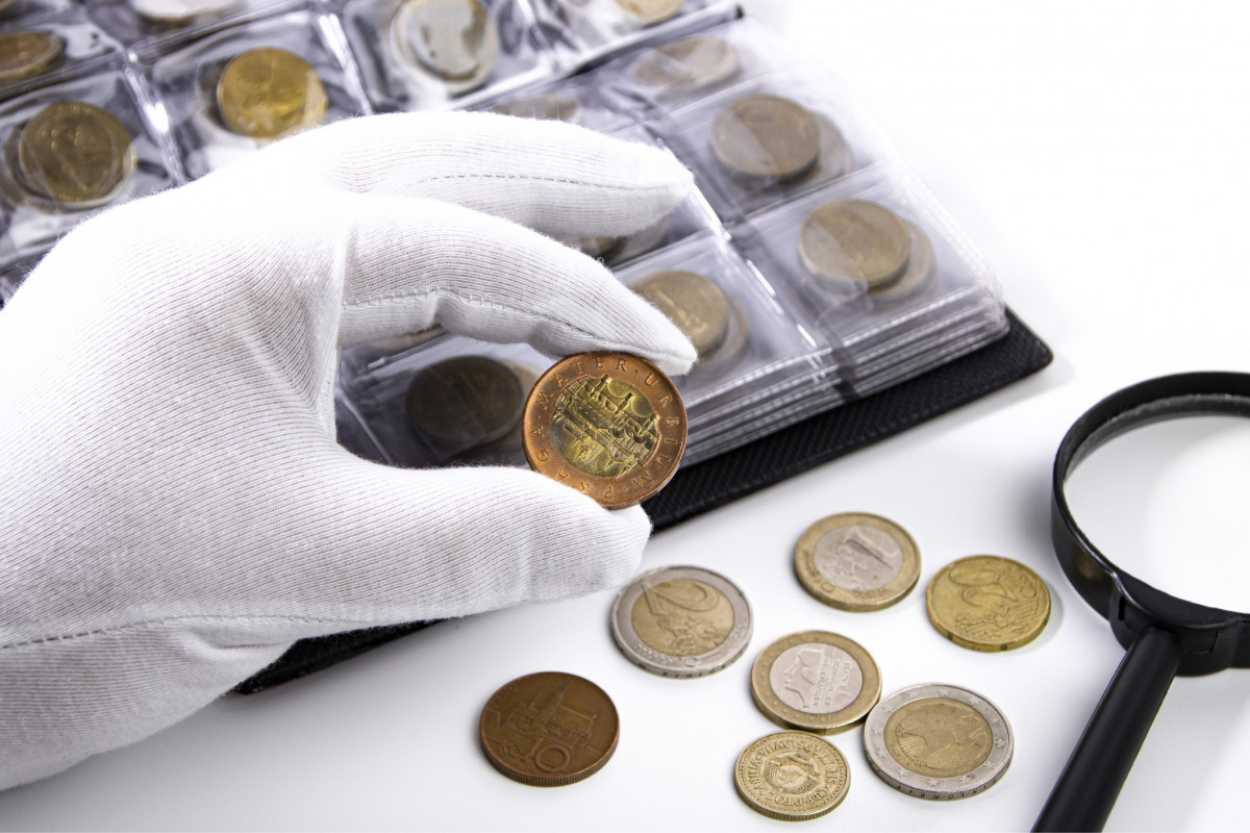In June 2021, a 1933 Double Eagle sold for a jaw-dropping $18.9 million. Sure, the coin was a fine specimen deserving of that sale price, but $18 million is the kind of money that grabs the attention of scammers, cons, and counterfeiters.
There have been numerous attempts to recreate U.S. coinage, with the 1909-S Penny being the most counterfeited U.S. coin. In a market that’s slowly turning into the Wild Wild West, your ability to identify counterfeit coins might just save you millions of dollars.
In this article, we’ll teach you how to separate the wheat from the chaff and the silver from the steel. But first, let’s familiarize ourselves with U.S. coinage.
Know Your U.S. Coins
Modern U.S. coinage has spawned six denominations, including pennies, nickels, dimes, quarters, half dollars, and dollar coins. Knowing the identity of these coins is key to knowing what’s real and what’s fake.
So why don’t we jog your memory by highlighting the key physical attributes of these coins:
| Denomination | Face Value | Color | Diameter | Thickness |
| Penny | $0.01 | Bronze | 19.05 mm
0.750 inches |
1.52 mm
0.060 inches |
| Nickel | $0.05 | Silver | 21.21 mm
0.835 inches |
1.95 mm
0.077 inches |
| Dime | $0.10 | Silver | 17.91 mm
0.705 inches |
1.35 mm
0.053 inches |
| Quarter | $0.25 | Silver | 24.26 mm
0.955 inches |
1.75 mm
0.069inches |
| Half Dollar | $0.50 | Silver | 30.61 mm
1.205inches |
2.15 mm
0.085 inches |
| Dollar | $1.00 | Silver | Eisenhower
38.10 mm 1.500inches
Susan Anthony 26.50 mm 1.043 inches |
Eisenhower
2.58 mm 0.102 inches
Susan Anthony 2.00 mm 0.079 inches |
| Gold | 26.49 mm
1.043 inches |
2.00 mm
0.079 inches |
The denominations represented above are only the tip of the iceberg that is U.S. coinage. 18th and 19th-century coins are more prone to counterfeiting due to their high value. It is important, I mean critical, that you research the coins you’re about to inspect so you don’t fall into the trappings of buying a fake coin.
Key Factors in Determining a Coin’s Authenticity

A coin’s physical features are key in determining its authenticity. Some of the parameters worth investigating include:
- Weight
- Coin diameter and thickness
- Edge engravings and details
- Metallic composition and magnetism
- Coin sound
But what techniques should you use to test these properties? A parameter like metallic composition appears difficult to confirm on paper because metallic analysis may require extracting physical samples of metal from a coin. But that would also mean destroying a rare and valuable relic.
So, how do you know the metals that a coin contains certain metals without necessarily destroying it? We have some useful techniques you ought to learn.
Detecting Counterfeits: Methods and Techniques
No, you don’t need a “Fake Coin Detector” to tell what is real and what is not. All you need are some non-intrusive techniques, and we have the scoop. We’ve identified visual inspection, magnetism, assessing weight and dimensions, and sound tests as simple and effective ways of authenticating U.S. coins.
Visual Inspection
The U.S. Mint goes to great lengths to ensure their coins look as exquisite as they do. Sometimes, a simple visual inspection is all you need to know whether a coin is real or otherwise. So, how do you do it?
Step 1: Find an Authentic Coin for Reference
If you’re going to inspect a coin, you should use a real coin as your reference. It may be impractical to purchase a real (and pricey) coin just to make comparisons. We recommend sourcing high-quality images from reputable sources. But if you’re going to get a physical coin for reference, ensure that it’s also from a reputable source. It would be calamitous to try to authenticate a coin using a fake as your reference.
Step 2: Study the Faces and Edges of the Coin
While the U.S. Mint makes its coins in coin presses, counterfeiters make their fakes through metal casting. The scammer will impress a real coin in a clay mold and pour in some molten metal. You can tell coins that were made using this technique by the horizontal seams that run along their edges.
Fake coins will also have inconsistent font sizes and images. The fonts will look cartoonish, with inconsistent curves around the edges of the lettering. Some unscrupulous sellers will try to convince you that it’s a strike-through error. And that, folks, is why you need multiple techniques to authenticate your coins.
Step 3: Study the Relief of the Coin
Historically, counterfeiters have had trouble getting the coin reliefs right. Some coins will show high relief, while others will exhibit shallow reliefs. Due to the inconsistent relief, fake coins don’t stack well. So, if a coin is having trouble stacking with similar coins, it’s probably fake.
Use of Magnetism
U.S. coins are made with all kinds of metals, including gold, silver, copper, nickel, and tin. Fake coins are made of cheap metals. And the thing about cheap metals is that most of them are magnetic.
Magnetism is an effective way of identifying the presence (or lack) of certain metals in a coin. Follow the steps below to use magnetism to authenticate your coins.
Step 1: Know the Coin’s Metallic Composition
Different coins will have different metallic compositions depending on the era it was struck and its denomination. For example, pre-1965 dimes, quarters, half dollars and dollars contained 90% silver and 10% copper. During WWII, certain denominations altered their metallic compositions to divert resources toward the war effort. The penny famously switched from bronze to steel planchets in 1943. Whatever your coin of interest, Google is your friend; find out its metallic composition.
Step 2: Find Out Whether the Metals are Magnetic
If a coin contains magnetic metals, it will respond to the pull of a magnet. But also remember, a coin that’s made of non-magnetic metals has no business sticking to a magnet.
Your steel 1943 Penny will be attracted to a magnet because it’s made of steel. Any other Lincoln Penny should not respond to a magnet because copper and zinc are non-ferrous metals. While tin is faintly magnetic, the coin contains very little of it (less than 5%) to make the penny magnetic.
Let’s look at the common metals found in coins and their magnetic properties.
| Metal | Magnetic Properties |
| Copper | Non-magnetic |
| Tin | Weakly magnetic |
| Zinc | Non-magnetic |
| Nickel | Magnetic |
| Manganese | Non-magnetic |
| Silver | Non-magnetic |
| Gold | Non-magnetic |
Weight and Dimensions
It’s very difficult for counterfeiters to get their dimensions and weight right. Some of these scammers will be hoping that you don’t notice the difference. So find yourself a suitable digital scale and a digital caliper, and get to measuring.
You should also know the right weight and dimensions for the coin you’re about to measure. A simple Google search should give you all the information you need. But to start you off, below is a comparison of the dimensions of the common coin series.
| Series | Diameter | Thickness | Mass |
| Jefferson Nickel | 21.21 mm | 1.95 mm | 5.000 g |
| Roosevelt Dime | 17.91 mm | 1.35 mm | 2.268 g |
| Washington Quarter | 24.26 mm | 1.75 mm | 5.670g |
| Kennedy Half Dollar | 30.61 mm | 2.15 mm | 11.34 g |
| Eisenhower Dollar Coin | 38.10 mm | 2.58 mm | 22.68 g |
| Susan B. Antony Dollar Coin | 26.50 mm | 2.00 mm | 8.10 g |
| Sacagawea Dollar Coin | 26.49 mm | 2.00 mm | 8.10 g |
| Presidential Dollar Coin | 26.49 mm | 2.00 mm | 8.10 g |
Sound Test
Silver coins have a very distinct sound. They ring in a distinct and resonant sound when struck with a hard object. So much so that the Ping Test has become a reliable way of detecting counterfeit silver coins.
To perform the Ping Test at home, follow the steps below:
- Balance the silver coin on your index finger.
- Strike the edge of the silver coin with another coin or hard object
- Listen to the sound of the ring or ping
- Repeat the process, striking different parts of the edge.
A real silver coin will produce a consistent sound no matter the side of the edge you strike. You see, a real coin will have a uniform thickness, and it will vibrate and ring with a consistent sound. But what does a real silver coin sound like? Real silver pings with a sustained high-pitched ring.
Here’s a video to help you out.
Final Thoughts
There’s a huge influx of counterfeit coins flowing in from China. With the strategies we’ve just shared, you should be able to differentiate the reals from the fakes. But you can always go a step further and put yourself in a position where you don’t have to encounter fake coins. The secret is to always buy your coins from reputable sources like Heritage Auctions, Great Collections, Stack’s Bower’s, and so on.
And if you’re going to invest in a pricey coin, pick those that are graded by reputable firms. And even before committing your money to the deal, look up these coins and authenticate their status with the coin grading firm.
It hurts to fall victim to a scam. It’s even more devastating to lose money while trying to invest in a hobby you love.

Jenson is a professional numismatist, a dedicated coin collector, a graduate of the College of Business at Oregon State, a life member of the American Numismatic Association (ANA), and an overall coin nerd. He is the founder of Coin Value List.
